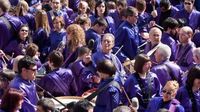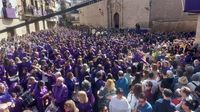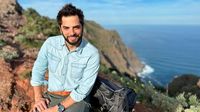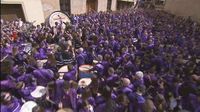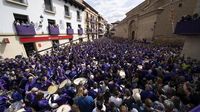On April 18, 2025, the small town of Calanda in Teruel, Spain, witnessed a momentous occasion as Diego Buñuel, the grandson of the legendary filmmaker Luis Buñuel, took center stage during the traditional 'Rompida de la Hora' ceremony. This event, which marks the death of Christ, is a significant part of the Holy Week celebrations in the region and has been recognized as Intangible Cultural Heritage of Humanity by UNESCO.
This year is particularly special as it commemorates the 125th anniversary of Luis Buñuel's birth, a milestone that resonated deeply with Diego. "It is an incredible honor to break the silence before everyone plays. I have seen many others do it, but I never thought one day it would be me," he expressed with palpable emotion as he prepared for the ceremony.
The 'Rompida de la Hora' involves thousands of drums and bass drums sounding simultaneously for an impressive 26 hours, creating a thunderous atmosphere that can be felt miles away. The event began in the early hours of Good Friday, with participants gathering in the town square to prepare for the moment when the first drum would sound.
Calanda, with a population of nearly 4,000, is one of the nine municipalities that participate in the Ruta del Tambor y el Bombo, a tradition that has grown in popularity and significance over the years. Each town has its unique way of celebrating, but Calanda stands out as the only location that officially breaks the hour at noon on Good Friday.
As the clock struck twelve, the atmosphere was electric. Diego, alongside Longinos—a character representing the Roman soldier who pierced Christ’s side—struck the giant drum in the plaza, marking the start of the festivities. The sound of the drums filled the air, breaking the silence that had enveloped the town and signaling the beginning of a celebration that draws thousands of spectators.
Diego's connection to Calanda runs deep. He reminisced about his childhood visits with his father and the impact of his grandfather’s legacy on his life. "It's fantastic for me, the idea of returning to Calanda again, because as a child I came regularly with my father. But returning this year, so special, to do the breaking of the drums is exceptional," he shared.
In his reflections, Diego acknowledged the surrealism and humor that defined his grandfather's work, which he believes are essential tools for confronting injustice and tyranny. Despite only having known his grandfather for a brief period before his passing, Diego’s memories of their time together are vivid. "I grew up around filmmakers, actors, writers, and painters. It was an incredible childhood, but what’s interesting is that everyone was creating fiction. Then one day, journalists from the New York Times came to talk about the war, and I thought, this is incredible; it’s not fiction, it’s reality. That’s why I started studying journalism," he recounted.
This year’s ceremony also attracted significant media attention, with over 40 foreign outlets, including those from as far as Japan and China, covering the event. The growing international interest highlights the cultural importance of the 'Rompida de la Hora' and its connection to the Buñuel legacy.
As the drums continued to resonate through the streets of Calanda, the vibrant purple robes worn by the participants created a striking visual against the backdrop of the spring sun. This moment is not just a celebration of tradition but also a tribute to the Buñuel family, who have played a pivotal role in promoting and preserving this unique cultural heritage.
The Brotherhood of the Santísimo de Calanda, which organizes the event, has its roots dating back to 1583 and consists of 33 members, all men, reflecting the strong religious character of the celebration. The brotherhood has been instrumental in maintaining the traditions of Calanda’s Holy Week, ensuring that the 'Rompida de la Hora' remains a significant event for both locals and visitors alike.
Three years ago, a bronze sculpture of Luis Buñuel was unveiled in the Plaza de España, depicting him playing the drum—a fitting homage to the man who immortalized this tradition in his films such as 'Nazarín' and 'Simón del desierto'. The statue stands as a reminder of Buñuel's contributions to cinema and his enduring connection to Calanda.
As the ceremony concluded, the collective energy of the participants and spectators underscored the importance of this tradition, which has been declared a Fiesta de Interés Nacional since 2004. The 'Rompida de la Hora' not only symbolizes the death of Christ but also serves as a powerful expression of community and cultural identity in Calanda.
In a world where cultural traditions face many challenges, the resilience of the 'Rompida de la Hora' and the Buñuel legacy shines brightly, reminding all of the power of heritage and the stories that bind us together. Diego Buñuel’s participation in this year’s event has not only honored his grandfather’s memory but has also renewed interest in the cultural significance of Calanda's Holy Week celebrations.
